Antipodes K41 and K22 Music Servers
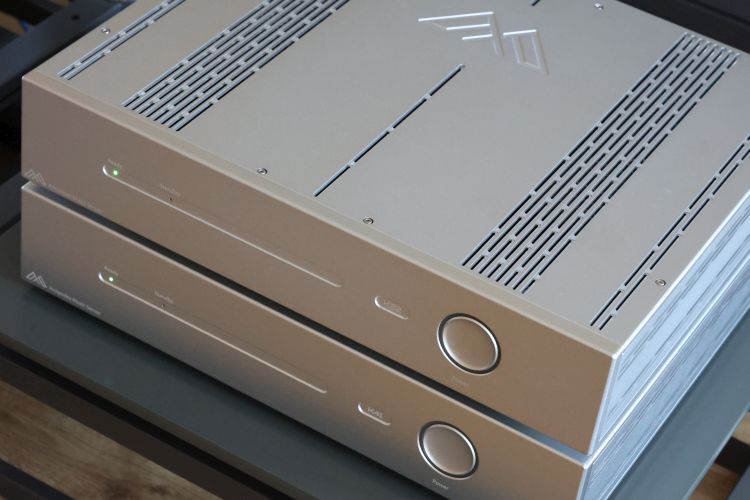
Review samples supplied by Antipodes Audio
Retail prices in the Netherlands incl 21% VAT:
K41: €9.995 excluding storage
K22: €8.995 excluding storage
Storage can be included at purchase or later installed by the user
Available in Black or Silver
K Series
The K21, K22, and K41 are Antipodes’ K-Series Modular Options. To explain these models, it’s easiest if we start with the all-in-one K50 that I reviewed in September 2020. The K50 is a single unit but it contains three separate processing engines for the Server apps, Player apps, and the Reclocking outputs.
The K22 and K41 actually offer the exact same quality as the K50 but at a significant cost-saving. If you already have a streaming DAC and are only looking for a server, you can get the K41 instead. For those who want to make their first step into the highest K-series tier, the K22 complete server+player solution is the perfect place to start.
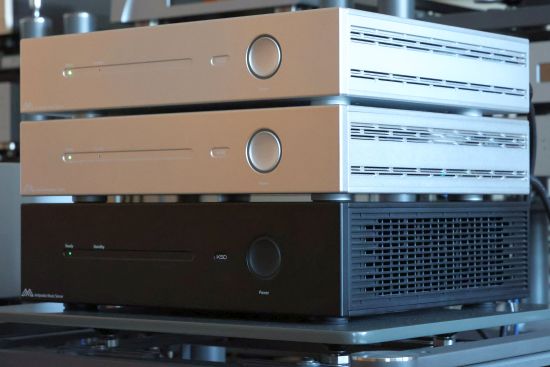
Stack of K50, K41, and K22
K22
The K22 includes the Player and Reclocker engines from the K50 which allows it to play to the USB, S/PDIF, AES3, or I2S inputs of an external DAC. The K22 is ideal if one already has a server and only requires a high-quality endpoint.
In addition, the K22 can also run Server apps, but is only medium-powered so is not suitable for very large libraries (>8TB) or heavy DSP functions. The K22 includes a single slot on the rear for user-installable SSD storage (up to 8TB). Users can upgrade later by adding a K41 server, improving server app responsiveness and significantly enhancing the sound quality.
K21
The K21 (not reviewed here) is the same machine as the K22 minus the Reclocker engine and the digital outputs. The K21 is a cost-effective endpoint for USB-only external DACs.
K41
The K41 is a Music Server only. It includes the same server engine as the K50 which allows customers to begin with a K41 and play to the Ethernet input on networked DACs. One can upgrade later by adding a K21 player (for USB output) or a K22 player (for USB and reclocked synchronous outputs S/PDIF, AES3, and I2S). Users can easily add up to three SSDs (up to a total of 24TB) via slots on the rear.
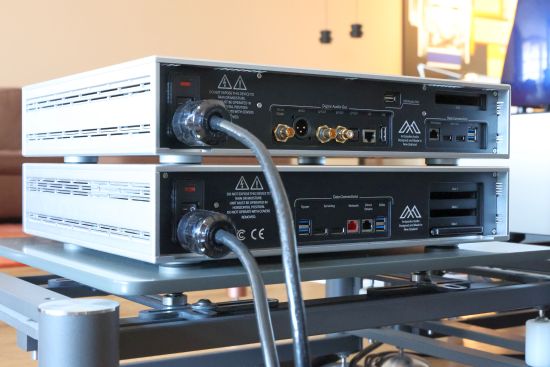
User Interface
Since the start, Antipodes Audio has emphasized having a well-thought-out user interface while allowing the user many server/player software solutions to choose from rather than just one. Models like the DX, CX, and EX were never hard to set up but that did not stop the company from continuously improving and refining the interface. The second-last AMS version 3 that I highlighted in an update of the K50 review introduced full integration of the Antipodes website with the local server/player user interface dashboards and was a marvelous upgrade over the previous version. With the current AMS version 4, Antipodes have outdone themselves yet again. The interface looks super-slick, has some clever new features, and is even easier to navigate than before.
When you know the Antipodes server’s IP Address you can always still approach its user interface by entering it in an internet browser. But the most intuitive way to approach the interface is by going to the Antipodes website and clicking the My Antipodes link. This will bring up an overview of all the Antipodes servers and players that are found on the local network along with highlights and links to access them directly. If no servers are found, the website automatically shows you the most common causes and helpful tips to restore the connection(s). Updates can be carried out with the click of a button and user Guides, the Community section, and an extensive help section are all available on the same page.
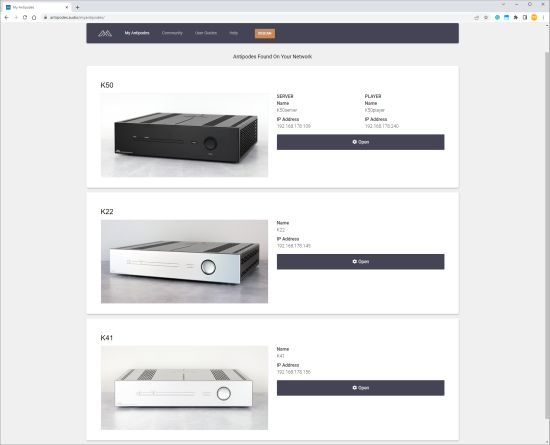
Below, I will highlight some of the User Interface functionality to illustrate how smoothly it works while setting up the K22 and K41.
K22 Basic Setup
To proceed, simply select a product by tapping the desired big grey “Open” button.
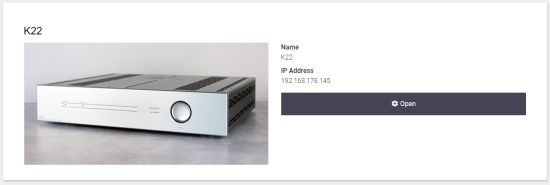
Starting with the K22 player, we are presented with the Solution page. This is a new addition that governs both the server and player on a single screen.
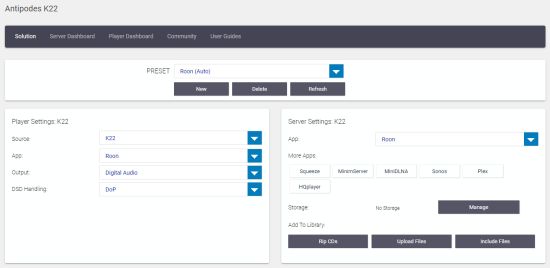
The Presets pull-down menu offers “smart” presets to create a working server-player pair using the App of your choice with the most likely digital output selected automatically in a single click.
Formerly, in a dual Antipodes setup, you needed to configure the task of each unit separately. Now, you only need to access the unit performing the Player function and the Solution Dashboard allows you to select any other Antipodes device on the network as its Source Server and allows managing the Server’s apps and storage setup, right from the Player’s Solution Dashboard.
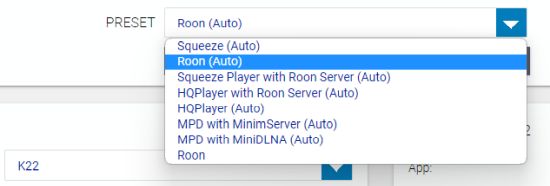
You can also create custom presets, and of course, you can still manually select the desired source, player app, digital output, and more.
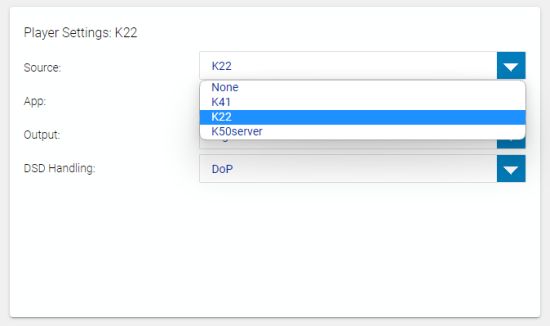
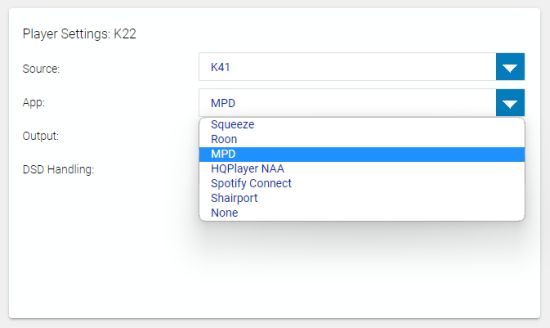
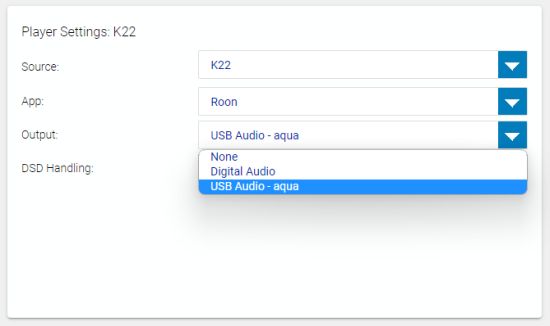
The next screen is the Server Dashboard which I will skip here as we will be using the K22 in its ideal guise, as a dedicated player. The screen after that is the Player Dashboard which provides a wealth of information and gives access to all the sub-options of the various player apps.
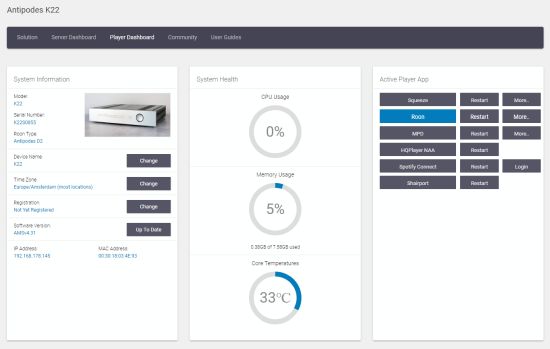
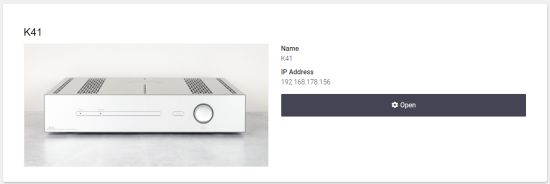
K41 Basic Setup
The K41 server has a similar user interface as the K22 that allows the selection of server apps. You can have multiple or even all apps running at the same time. For the best sound quality, however, it is usually best to only have the required apps running.
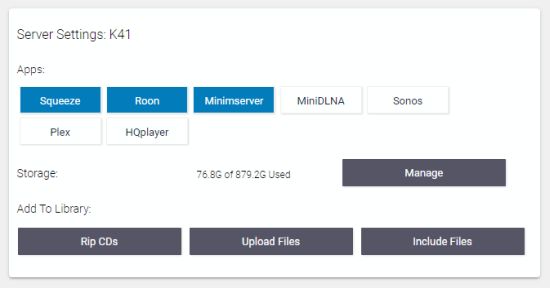
Since the K41 is a Server only, there are no options available in the player section.
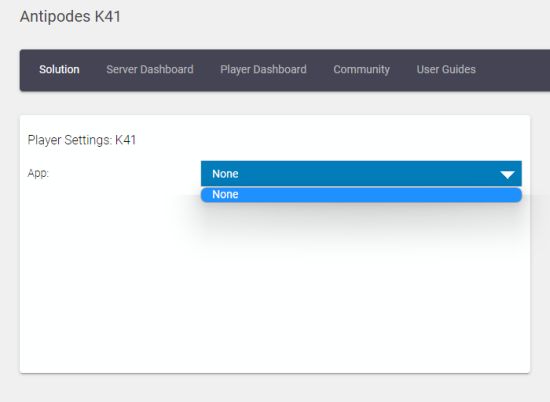
Of course, it does show all the options for the Server section on the Server Dashboard.
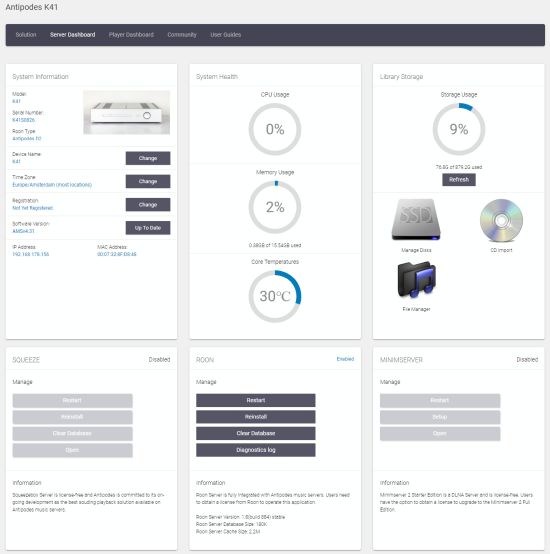
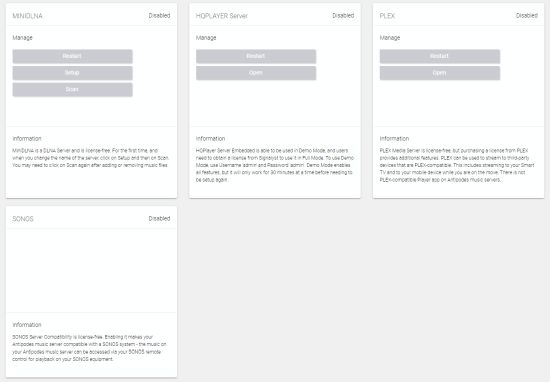
There’s much more to say about the user interface, but for now, please just trust me when I say that Antipodes have thought of everything. See the Guides section for all the ins and outs.
Importantly, the interface is set up such that it remains very simple while still offering all the handles to dive in as deeply as you like. It is easily the slickest and most intuitive interface that I have used. Oh, and because it is a web interface, it will work on any networked device that has an internet browser.
Next: K50 Backstory
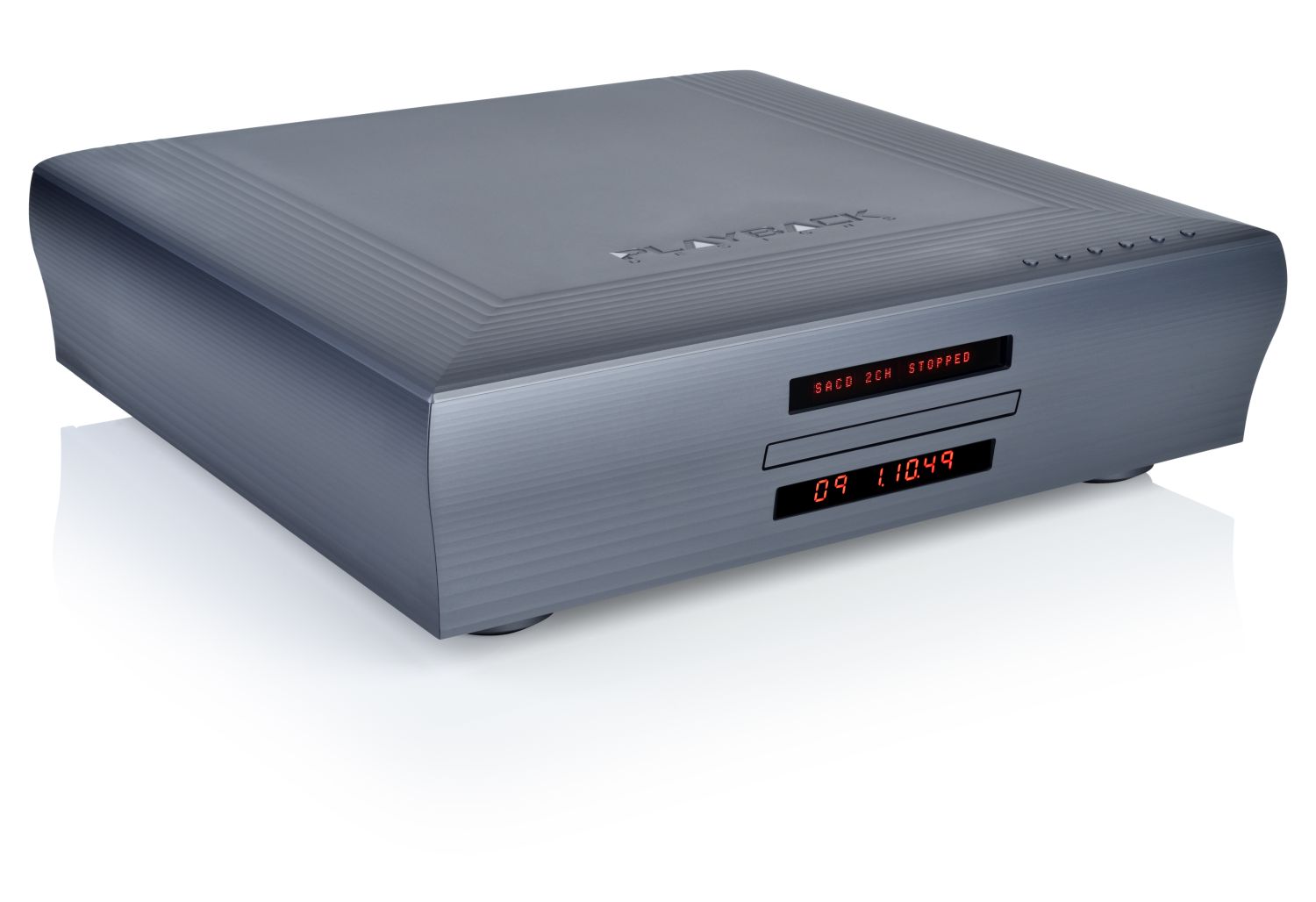







Thank you for such a thorough explanation of the component interactions, configurations and tweaks. Nobody else I found does this like you do. This is why I value you as the best resource to understand how music servers sound.
Thank you for your kind words.
Hi — just wondering if you have a review of the Oladra on the horizon. Thanks. David
I do indeed:-) It’s on its way here but I have several other reviews cued up so it will probably be ~2 months before it’s done.
Great, thanks. I look forward to it.
Hypothetically speaking, if you already had a very well reclocked high end streamer and USB DAC, would the K41 connected through the network as a Roon Core, contribute to a better sound compared to NUC with external LPSU running Rock?
I’ve not yet worked with Roon Rock but in my experience so far, the influence of a server is always audible. I must add that I have little experience with external clocking. Theoretically, this could reduce the difference, although I’d wager that there will always be an audible difference, no matter what you do. Power supplies also have a huge impact on the end result but I’ve not yet encountered a server that sounds quite like an Antipodes.
In my experience, yes. I combine an Esoteric N-01 with the Antipodes K41 (with the N-01 functioning as a streamer and DAC). Before that I had an Antipodes EX. The switch from EX to K41 was significant.
I have used the Bubble UPnP app for Android for years. The new application for IOS , JPlay UPnP , is much better , it has less impact on the network and the SQ obtained is much higher , besides being the competition of ROOM in metadata . Although it is priced higher than Bubble, €50 per year, it is the best investment. You should try it , there is a free trial month . Carlos
Thanks for this superb review, Christiaan. I’d been considering a move to the K50 from my Sonore Rendu and a K50 customer and friend suggested I consider the K22 which would deliver the same SQ bump as the K50 while allowing me to keep my SonicTransporter server, thereby saving the difference between the the K22 and the K50. Sure, if money no object I’d be all in for a K50, but the price is a bit hefty for me at this time.
So in your opinion, given the accolades that you ascribe to the K41, would this solution be a viable one, or would the system suffer by “compromising” in choosing only the K22? I’m using the Mola Mola Tambaqui DAC and the Manual preamp into a Class A Krell Thanks
Hi Bob, indeed, a K22 is essentially the player section of the K50 As mentioned in the review, adding the K41 or getting a K50 does make a difference still, but much of the Antipodes experience is in the player and especially the Reclocker section. This makes getting just the K22 a smart move and a great way to save some money. And you can always add the K41 later if you get the upgrade itch;-).
Thank you, Christiaan; your incredible knowledge and judgement account for why you stand out in a crowded field. We all appreciate you. This edges me closer. I was kind of torn between purchasing a (slightly) used K50 Gen3 or this Gen4 K22. Seems to make sense to go new and current … 🙏🏻